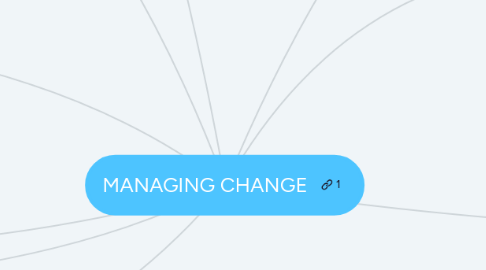
1. A description of traditional practices in and theories about organizations that likens the organization to a large ship making a predictable trip across a calm sea and experiencing an occasional storm
1.1. Change in “Calm Waters” – Unfreezing – Implementation of change – Refreezing
2. Change agent
2.1. A person who initiates and assumes the responsibility for managing a change in an organization
3. Basic Questions for Change Agents
3.1. What are the forces acting upon me?
3.2. What should we change?
3.3. How should we change it?
4. Forces for Change
4.1. External Forces
4.1.1. Competition Laws and regulations
4.1.2. New technologies
4.1.3. Labor market shifts
4.1.4. Business cycles
4.2. Internal Forces
4.2.1. Strategy modifications
4.2.2. New equipment
4.2.3. New processes
4.2.4. Workforce composition
4.2.5. Labor surpluses and shortages
5. Views of the Change Process
5.1. “Calm waters” metaphor
5.2. “White-water rapids” metaphor
5.2.1. A description of the organization as a small raft navigating a raging river
5.2.1.1. Change in “White-water Rapids” • Change is constant in a dynamic environment • The only certainty is continuing uncertainty • Competitive advantages do not last • Managers must quickly and properly react to unexpected events
6. Reasons why people resist change
6.1. 1- Fear for the unkwnown
6.2. 2. Fear of losing something of value
6.3. 3. Belief that change is not good for the organization
7. Organizational Change
7.1. An alteration of an organization’s environment, structure, culture, technology, or people – A constant force – An organizational reality – An opportunity or a threat
8. Step Process For Leading Organizational Change
8.1. 1. Create a Sense of Urgency
8.2. 2. Decide What to Change
8.3. 3. Create a Guiding Coalition and Mobilize Commitment
8.4. 4. Develop and Communicate a Shared Vision
8.5. 5. Empower Employees to Make the Change
8.6. 6. Generate Short-Term Wins
8.7. 7. Consolidate Gains and Produce More Change
8.8. 8. Anchor the New Ways of Doing Things in the Company Culture
8.9. 9. Monitor Progress and Adjust the Vision as Required
9. Organizational Development
9.1. ¿What is?
9.1.1. An approach to organizational change in which the employees themselves formulate the change that’s required and implement it, usually with the aid of a trained consultant.
9.2. OD Interventions
9.2.1. - Human Process Interventions Aimed at enabling employees to develop a better understanding of their own and others’ behaviors for the purpose of improving that behavior such that the organization benefits.
9.2.2. -Sensitivity Training (Laboratory or T-groups) Purpose is to increase participants’ insight into their own behavior and that of others by encouraging an open expression of feelings in a trainer-guided group.
9.3. Organizational Stressors: Role Demands
9.3.1. 1. Role conflicts :Work expectations that are hard to satisfy
9.3.2. 2. Role overload: Having more work to accomplish than time permits
9.3.3. 3. Role ambiguity: When role expectations are not clearly understood

